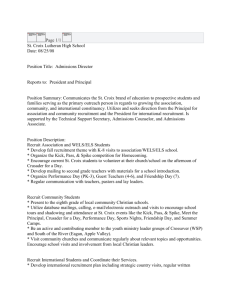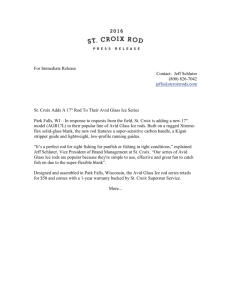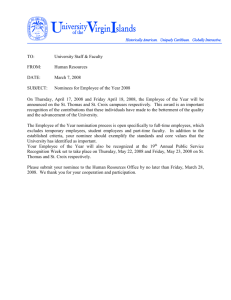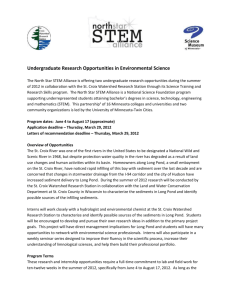Management of the Lower St. Croix Riverway:
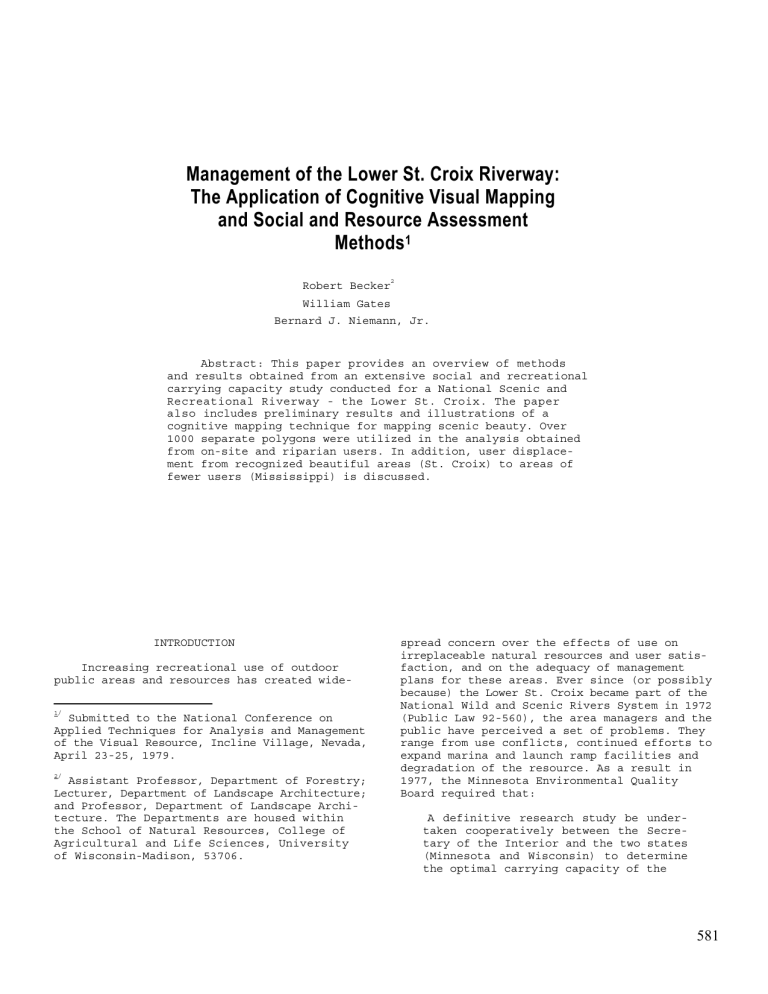
Management of the Lower St. Croix Riverway:
The Application of Cognitive Visual Mapping and Social and Resource Assessment
Methods
1
Robert Becker
2
William Gates
Bernard J. Niemann, Jr.
Abstract: This paper provides an overview of methods and results obtained from an extensive social and recreational carrying capacity study conducted for a National Scenic and
Recreational Riverway - the Lower St. Croix. The paper also includes preliminary results and illustrations of a cognitive mapping technique for mapping scenic beauty. Over
1000 separate polygons were utilized in the analysis obtained from on-site and riparian users. In addition, user displacement from recognized beautiful areas (St. Croix) to areas of fewer users (Mississippi) is discussed.
INTRODUCTION
Increasing recreational use of outdoor public areas and resources has created wide-
1/
Submitted to the National Conference on
Applied Techniques for Analysis and Management of the Visual Resource, Incline Village, Nevada,
April 23-25, 1979.
2/
Assistant Professor, Department of Forestry;
Lecturer, Department of Landscape Architecture; and Professor, Department of Landscape Architecture. The Departments are housed within the School of Natural Resources, College of
Agricultural and Life Sciences, University of Wisconsin-Madison, 53706. spread concern over the effects of use on irreplaceable natural resources and user satisfaction, and on the adequacy of management plans for these areas. Ever since (or possibly because) the Lower St. Croix became part of the
National Wild and Scenic Rivers System in 1972
(Public Law 92-560), the area managers and the public have perceived a set of problems. They range from use conflicts, continued efforts to expand marina and launch ramp facilities and degradation of the resource. As a result in
1977, the Minnesota Environmental Quality
Board required that:
A definitive research study be undertaken cooperatively between the Secretary of the Interior and the two states
(Minnesota and Wisconsin) to determine the optimal carrying capacity of the
581
Lower St. Croix Riverway...to identify resource constraints, facility capacities, and sociological or socioesthetic values. Any future access expansion, site development and water or land zoning would benefit from guidelines determined in this matter.
Why is this study important? Why the interest in the Lower St. Croix? Why was the
Lower St. Croix included as a National Recreational and Scenic Riverway? Why was the entire St. Croix system considered to be so significant and unique that it was worthy of being a major component in the National Riverway System and the only component included from its headwaters to its confluence? The reasons have something to do with the uniqueness of the riverway, the recreational opportunity, the quality of the resource, and the proximity to a large metropolitan user population. Also in comparison with over riverways in the U.S., the
St. Croix represents one of the last remaining recreationally unimpaired riverway system in the Upper Mississippi Basin (Upper Mississippi
River Basin Commission 1970).
While considerable information is known about the characteristics and distribution of the biological, physical and physiographic characteristics of our natural areas and a growing base of information is at hand regarding user characteristics, little has been done to merge these components. Social and resource data have existed in separate realms. This separation is incongruent with the theme of optimal resource utilization. To overcome this separation, this river recreation carrying capacity project consciously sought to interface both the social and resource data sets (Becker,
Gates and Niemann 1978).
To accomplish the directive of the Minnesota Environmental Quality Board; responding to the need for merging the physical characteristics of the riverway with its use patterns, and the requirement of understanding the regional uniqueness of the setting and experience, an integration of methods was employed. The array of methods employed, the results and the subsequent management action are the focus of this paper.
In summary, the study goal was to understand:
(1) the effects of riverway users upon other riverway users;
(2) the effects of riverway users upon the resource; and
(3) the effects of the resource upon riverway users.
582
METHODS
To accomplish the study goal, the research team employed an integrated set of social and resource measurement and analysis techniques.
These included questionnaire measures from onsite users, riparian landowners, the St. Croix
Riverway managers, and river users on the nearby
Mississippi. The on-site and riparian landowner questionnaires and some questions were located and coded geographically. They provided user generated geographic perceptions, e.g., scenic beauty, areas travelled, areas avoided, etc., by a cognitive mapping procedure included in the self-administered questionnaire. Over 2,000 questionnaires were obtained and analyzed requiring extensive data base management with innovative display and analysis procedures.
For example, because geographic coordinates were maintained on every questionnaire, it was possible to use computer graphics to depict areas along the river travelled by various types of boats, and areas considered most beautiful. The study was also one of the first to test the concept and obtain results that recreation-use is a social/spatial phenomenon. For example, both on-site users and riparian landowners mapped specific information in the form of polygons on a map provided as part of their questionnaire.
Figure 1 shows the actual map, directions and symbols employed. The original scale in the questionnaire was 1
"=
5.77 miles. While cognitive mapping techniques have received historic criticism regarding inability of individuals to read or comprehend maps, users on the Lower St.
Croix exhibited a remarkable ability to record spatial properties. Over 78 percent of on-site users and over 81 percent of landowners identified riverway locations they considered beautiful as well as the physical/social characteristics they associate with these areas (see figure
1). This resulted in over 1,000 individual polygons which require combinative analysis. Also, because geographic information was maintained, the concept of use displacement in both time and space was tested and substantiated.
To determine water craft distribution, type of use, and density of use slightly oblique black and white aerial photography was employed. The method included the use of two canted 35 mm Nikon motor drive cameras (see figure 2). An example of the results can be observed in Figure 3. This is 15x magnification of the 35 mm photography using a Bausch and
Lomb 200 mm stereoscope. At this magnification boats can be classified according to type.
Four cabin cruisers and one house boat are shown.
Figure 1. Map and Related Questions.
583
Figure 2. 35 mm Nikon Motor Drive System.
Figure 3. Enlarged 35 mm Photography.
The resource conditions were obtained from a set of 52 randomly located transects along which plant communities, plant species, soil texture, relief, orientation and recreational disturbances were collected and analyzed. In addition, disturbance measures were obtained from 10 percent of the recreation sites, comparative plant community measures were obtained to determine how much recreation activity was changing these community structures, and litter measures were also conducted.
Another source of resource information was obtained from two 1:24000 (spring and fall) color infrared flights of the riverway. Various resource measures were interpreted from this photography and placed into a 3-acre interactive geobase (GRASP) (McCown, Butler and Gates
1975).
584
Data Collection Methods
Instrument and Method Summation
On-Site Questionnaires--A pilot on-site survey was conducted between May 23 and June
19, 1977 and 1704 final questionnaires were used between June 20 and September 5, 1977. Two compatible questionnaires were distributed equally over selected times and locations over the entire 52 miles of the Lower St. Croix
Riverway.
Landowner Questionnaires--All adjacent riverway and private owners were identified from both the Minnesota and Wisconsin portions. In
July, approximately 900 valid residents were established and eventually 420 were returned for analysis.
Regional Questionnaires--In December 1977,
900 Lower St. Croix and Upper Mississippi onsite users were sent a regional questionnaire.
A total of 502 regional questionnaires were returned for analysis.
Manager's Questionnaires--Questionnaires were mailed to 30 riverway managers, 28 were returned for analysis.
35 mm Aerial Photography--Thirty-eight 35 mm water craft user flights were obtained between May 23 and September 5. Twenty-two flights were determined acceptable for analysis.
Fifteen flights were utilized to determine overall water craft use and distribution.
Resource Data Collection Methods
Transect Measurement --As described earlier,
52 transects were located from which on-site questionnaires were obtained and along transects upon which the resource was inventoried. Various types of resource information were recorded including plant communities, plant species, soil texture, relief, orientation and recreational disturbances.
Disturbance Measures --This technique involved quantitatively comparing the percent and type of disturbance for approximately 31
(10%) recreational sites (e.g., marina, beach, island, etc.). Indices such as "weed" species
p lus non-vegetative features such as litter, asphalt, etc., were utilized as indicators of disturbance.
Community Measures--This technique was utilized to measure, quantitatively the degree to which sites in heavily used recreation areas have vegetatively changed due to use. Three pairs of sites were sampled plus one dredge spoil island.
Visual Water, Litter and Noise Quality
Measures--These quality conditions were made at each site where questionnaires were obtained;
125 samples were obtained from 105 sites.
Additional Sources--Additional information about the resource (e.g., water level changes) was obtained from two 1:24000 color infrared flights. In addition, information about the resource, particularly wildlife, was obtained from interviews with local experts.
RESULTS
Use Patterns
In 1970, the Minnesota-Wisconsin Boundary
Area Commission estimated that approximately
205,000 persons visited the area via watercraft. During 1977 a use estimate of 832,649
(+ 8.4 percent error) was generated representing an increase in excess of 406 percent in just seven years. In 1970, a high use boat estimate of 800 was reported. In 1977, utilizing an aerial camera technique a high use daily estimate of approximately 3384 was derived, with a total boat estimate of 219,118 from Memorial Day through Labor Day. This represents an increase of 423 percent or 22 percent per annum growth in seven years.
Use of 35 mm aerial photographic analysis provided more than simply a means of counting boats. The results from the technique indicated that lower river surface use was affected by launch ramps (approximately 64 percent) more than slippage (36 percent). The technique provided a basis for monitoring watercraft distribution. Time photoanalysis results reveal approximately 60 percent of all crafts on the riverway are stopped at any given time. This compares with user questionnaire results of over 64 percent of users reporting stops.
As previously discussed a primary study objective was the integration of social and natural phenomena via their spatial and temporal locations. To accomplish this social data collection methods were constructed to associate user responses with a geographical area or place. The on-site questionnaire asked users to make some of their responses on a map included in the questionnaire. This afforded a mapping of: attitudes, behavior patterns and aggregate preferences over the geographical surface of the riverway. For example, areas of the river most heavily travelled are graphically depicted in Figure 4.
Figure 4. Areas Travelled.
Use is significantly higher on the lower reach of the Lower St. Croix (a deep water area).
Examination of the computer generated plot reveals heaviest travel in the Stillwater area, through the Hudson Narrows, and the Kinnickinnic
Delta on the lower river and Interstate Park to
Osceola on the upper reach. Figure 4 further reveals, for example, numbers of beginning trips at Taylors Falls and taking out at Osceola and
William O'Brien, an area dominated by day-use canoeists. The influence to the Lower St.
Croix from the Mississippi is also evident in presence of a high trip "end" point at Prescott.
The "end" category refers to northern and southern points of area traveled.
Resource Conditions
As previously mentioned in the introduction, to understand the interaction between the recreational use and the physical characteristics of the riverway, a series of resource data collection methods were employed. Resource quality measured received considerable attention because of their importance, but also because resource
585
quality is very important to users of the Lower
St. Croix who are seeking an unimpaired recretional experience.
In general, the investigators found that the Lower St. Croix Riverway is composed of striking as well as subtle natural features.
For example, the striking features near Taylors
Falls include sheet basalt rock surfaces and unusual rock potholes. In other riverway locations, Pre-Cambrian sedimentary rock bluffs and cliffs are exposed. In some areas which are unaccessible to the white tailed deer, the once pervasive but now rare Canada yew (Taxus canadensis) can be observed.
The Apple River Delta, in contrast, consists of an interlaced network of wetland and shallow water channels where patches of wild rice (Zizania acquatica) exist. These wild rice patches attract various and interesting types of migratory waterfowl. In some isolated upland areas, the rare and endangered and highly sought after Ginseng (Panax quinquefolium) can be observed. In the lower riverway near the
Kinnickinnic River Delta isolated prairie environments are observable.
More specifically, the application of methods for determining interaction between the recreational and riparian user and the resource, the transect results are of interest. The transects were used as a basis to monitor the condition of 17 representative plant communities.
An array of pre-selected vegetational disturbance indicators were utilized.
The highest recorded disturbance along the river is the presence of trails which occurred in 16.9 percent of the sample communities.
Highest occurrence of trails is in the Lowland
Forest (24.3 percent) which according to its distribution, accounts for almost the entire shoreline and island vegetation. Litter was recorded in 13.3 percent of the stands and has its highest frequency value in the lowland forest where 41.8 percent of the litter was found.
Another 12.7 percent was found in the sandbarmudflat-shoreline communities. These two community types account for most of the useable island and shoreline space. Litter was found in 15 of 17 community types. Hacked wood has been recorded in 9.6 percent of the stands.
Of the occurrences of this disturbance type,
35 percent were recorded in the lowland forest community, 10 percent were in the wet-mesic forest, which is often adjacent to the lowland forest, and 10 percent in the cliff communities adjacent to lowland and wet-mesic forests.
This indicates that users are depleting the supply of natural firewood on the islands (the lowland forest communities) and are beginning to cut standing timber. Trampling was found
586 in 8.7 percent of the samples and is important because of its relatively high occurrence in island and shoreline community types, including
25 percent in lowland forests, 16.7 percent in sedge meadows and 11.1 percent in sandbar-mudflat-shoreline communities. Several of the dry prairie remnants have been noted for possible preservation by the Scientific Area Preservation
Council of the Wisconsin Department of Natural
Resources.
Perception of the Resource
Beauty and unique environmental areas are the elements of the Lower St. Croix Riverway most often cited as special by users. It is interesting to note portions of the Riverway various users called beautiful (figure 5).
There is a strong relationship between the portions of the river the on-site visitor uses and the area identified as beautiful: Interstate, Rock Island; Apple River Delta; and Kinnickinic Delta.
Figure 5. Beauty Along the Riverway as Perceived by Users in Various Boat Types.
Figures 6*and 7*illustrate the character and type and density of the use of the Kinnickinnic
River Delta. Figure 6* is a high oblique photograph of the Kinnickinnic River Delta State
Park. This is a unique recreational resource within the lower reaches of the Lower St. Croix
River because of its expanse of beach space.
Figure 7*is a low oblique photograph taken of the lower right portion of the Kinnickinnic
Delta from the opposite direction as figure 6*.
It illustrates the importance and competition for available beach space among users of the lower portion of the St. Croix. Within each of the three areas, the resource characteristics
*See color illustration on page 396.
which affect the perceptions of beauty were sampled (see figure 1). This analysis is presently in progress.
Preliminary analysis indicates that those resource qualities associated to areas with high visual quality are characterized and perceived in a common way across on-site user groups. It also appears that generally the absence of man-made intrusions such as litter and development are common attributes of the areas considered most beautiful.
In contrast to on-site user beauty responses, which was associated with areas travelled, riparian landowners' identification of beauty was not associated in proximity to their residence. Figure 8 exhibits the landowner pattern of perceived beauty compared with the on-site users' perception of beauty.
Figure 8. Most Beautiful Areas on the Lower
St. Croix River.
This plot represents the aggregation of
810 on-site user-generated polygons and 261 riparian landowner polygons. Distance from the X axis to the curve represents the proportion of each response group identifying specific grid points along the riverway which were included in "their" beauty polygon. As would be expected variance existed regarding the geographic specificity of respondents, i.e., the size of their polygon. The small scale of the map probably contributed to polygon variance as would probable data extraction error.
Data were removed from the map via an eighty-three point grid overlay. "End" values
(horizontal grid lines) of each polygon were identified and encoded along with other survey responses. These points afforded calculation of polygon length and location. Polygon sizes ranged from 1 grid point to 83 grid points
(distance between adjacent grid points represents .59 miles) with a mean polygon size of
15.9 grid points (measures of central tendency presented represent landowner responses). However, the mode size was only 7 points or approximately 4.13 miles, with 1 to 7 point polygons representing 35 percent of respondents. Fifty percent of the respondents had polygons of 10 grid points or less, enclosing approximately
5.9 miles or less or one (1) inch on the map provided (see figure 4). Thus it appears that users indeed tried to be highly specific and were in all probability constrained by the instrument rather than by their spatial knowledge of the riverway.
Historically the limitation on user-generated polygon data albeit most user-generated data with spatial properties, was the number of hand overlays that could be competently interpreted. With an excess of 1000 polygons requiring analysis, an algorithm which associated their spatial characteristics was developed.
This in essence is represented by the assignment rule:
Pij = Pij + 1 where j = 1, ..., N individuals and i = b, ...,t b = bottom box or polygon code (limit 83,
1 grid lines) t = top box or polygon code (limit 83, 1 grid lines) conditional to b<t
(N in our example was the 261 landowner respondents).
IMPLICATIONS
The Lower St. Croix and Mississippi River
(Becker 1978) studies exhibit the ability and technologies which exist to understand human use on our natural areas. We can analyze individuals' reactions and qualitative perceptions of the resource, such as beauty, yet we continue to view our resource as a monolithic unit separate from other resource areas with users and use levels something that happens to the area rather than something that happens due to the area. We manage (or at least attempt to manage) for scenic quality or beauty under the assumption that quality of environment for an area is a universal amenity (an assumption that may require examination).
587
The Concept of Displacement
(and Substitutability)
As the prefix implies, displacement is a move away from an unacceptable situation, rather than a move toward an acceptable one. Thus displacement and substitutability are related concepts in that the amount and rate of displacement may be modified by the availability of substitutable experiences and resources.
Adjustments of use both in time and space are involved.
A number of river studies (on the Colorado,
Shelby and Nielsen 1975; Brule, Heberlein and
Vaske 1977) have shown that at any given point in time, on any river, the majority of users will say they are satisfied with their experience. That is, in a one-time site-specific experience study, the dominant response will be yes, we are satisfied. Simply by being at that river, the majority are accepting the situation at that site at that time.
It is to be expected that most of the minority who express dissatisfaction with their experience will eventually do something about it. Identified from other studies, possible responses to dissatisfaction are changing the day or time of day of a visit, changing the location on the river of the visit, changing rivers, and, changing activities entirely, i.e., no longer boating. So the question is no longer
"who is satisfied now with their experience on a river," but "are those who are satisfied now the same group who were satisfied five years ago on this site -- and, if not, where have these people come from and where have the others gone?" To answer such questions, one-river studies must be tied into the context of other similar rivers in the same region and thus into the concept of movement behavior, or displacement.
If, as in the case of the St. Croix, there is another substitutable river (the Upper Mississippi) within a reasonable distance relative to travel time and cost, users may change rivers altogether. In fact, in the presence of a relatively nearby substitutable river, users may often make this change first. In the absence of a substitutable river, users may more slowly make the other changes in time and space.
The theme of user displacement was a central focus of the regional questionnaire. It was hypothesized that displacement occurs successively to varying degrees. As use increases those users who are density sensitive adjust their use in various ways. The regional survey posed a series of questions aimed, in part, at determining what displacement moves, if any,
588 were occurring on the Lower St. Croix and the
Upper Mississippi.
The results of the regional survey suggest that displacement in both time and space is occurring on the Lower St. Croix, in relationship to the Upper Mississippi. Respondents from the St. Croix reported that they had avoided weekends and holiday use periods: a majority said they have attempted to avoid crowds by selecting a time they thought the fewest people would be on the river; half have used a section of the river they knew was not crowded; 6 percent have used other rivers altogether, including the Upper Mississippi.
It has been established that users of the
Lower St. Croix and the Upper Mississippi were equally satisfied with their visits to these rivers. Other results from the regional survey indicate that these different relationships found between satisfaction and the perception of crowding on the two rivers suggests that
Upper Mississippi users (1) expect to see fewer people and (2) are more sensitive to crowding than Lower St. Croix users. A possible explanation for the relationship between perceived crowding and level of satisfaction may be that current Upper Mississippi users are simply more density sensitive than those currently using the Lower St. Croix. The St. Croix users who were not sensitive may have displaced to other rivers, including the Mississippi. Those Upper
Mississippi users responding to the regional survey who formerly used the Lower St. Croix cited crowding (63 percent) as the dominant reason for their displacement. (Less than .1 percent of those using the St. Croix who had formerly used the Upper Mississippi cited crowding as a reason for leaving.) As use levels increase, it is likely that this pattern will continue.
When asked to rank a number of rivers they had used for a series of characteristics, those surveyed from both rivers ranked the Upper Mississippi as the "least crowded" with the best overall recreation experience. The Lower St.
Croix was similarly ranked as the "most beautiful" and having the best environmental quality.
A shift of users from one river nationally designated "wild and scenic" and deemed to have a better resource quality to another deemed to have a better overall recreation experience
(including less crowding) and poorer visual quality, may indicate that, for those who spatially displace themselves, the desired experience itself is a more driving factor than the aesthetic quality of the setting.
Thus while we can determine characteristics and spatial locations that individuals describe as beautiful and, while we can manage to protect or enhance these characteristics, a fundamental
question of "beauty for what?" must be incorporated into any management plan. The concept of visual quality or landscape quality requires definition in a context of user perceptions and expectations for a desired experience associated with that resource. If user density expectations of beautiful areas are not included into the measurement of beauty will there be much beauty to enjoy?
EPILOGUE
On October 4, 1978, the Lower St. Croix
Management Commission resolved the following:
Whereas, the Final Master Plan for the
Lower St. Croix National Scenic Riverway establishes some uniform policies and recommends 'a definitive research study should be undertaken...to determine the optimal carrying capacity... to identify resource constraints, facility capacities, and...socioesthetic values. Any future access expansion, site development, and water or land zoning would benefit from such guidelines...and,
Whereas, such a definitive study was conducted by the University of Wisconsin-Madison during the summer of
1977...and,
Whereas, said study...shows clearly that water based recreational use of the Riverway is rapidly increasing and causing crowding, potential serious safety problems, conflicts between users and riparian landowners, and seriously reducing resource quality.
(Lower St. Croix Commission 1978, pp. 1-2).
The outcome of this resolution(s) remain in doubt. The managers seem unwilling to acknowledge that the question of "optimal carrying capacity" is also social capacity and not solely a resource capacity question. As stated by a Commission of the Minnesota Department of
Natural Resources:
I'm saying that this river (Lower St.
Croix) belongs to all of us and we should by the expertise that's represented here at least admit that we have the ability to manage the river to the point where it won't be (physically) degraded. (Lower St. Croix
Commission 1978, pp. 14-15).
The eventual experiental future and the
"beauty" of the Lower St. Croix may be decided shortly. A new marina development permit has been applied for by a developer. How will the managers respond?
LITERATURE CITED
McCown, Brent, and Kent Butler and William
Gates
1978. A documentation of the resource information package, GRASP, and its application to the Lake Superior Shorelands. Institute for Environmental Studies, University of
Wisconsin-Madison. 100 pp.
Becker, Robert, William Gates and Bernard J.
Niemann, Jr.
1978. User and resource conditions: the lower St. Croix river study, preliminary and final drafts. School of Natural
Resources, College of Agricultural and
Life Sciences, University of Wisconsin-
Madison. 498 pp. and approximately 300
PP.
Becker, Robert
1978. Upper Mississippi dredged material disposal site recreational user assessment.
Department of Forestry, School of Natural
Resources, College of Agricultural and
Life Sciences, University of Wisconsin-
Madison. 175 pp.
Shelby, Bo and Joyce M. Nielsen
1975. Use levels and user satisfaction in the Grand Canyon. Rural Sociological
Society Proceedings, San Francisco.
Heberlein, Thomas A. and Jerry Vaske
1977. Crowding and visitor conflict on the
Bois Brule River. Technical Report -
Water Resources Center, University of
Wisconsin-Madison. 59 pp.
Lower St. Croix Commission
1978. Minutes of Special Meeting - Resolution. October 4, 1978, pp. 1-2.
Upper Mississippi River Basin Commission
1970. Upper Mississippi river basin study - Appendix K, Recreation. Ann
Arbor: U.S. Department of the Interior,
Bureau of Outdoor Recreation, pp. k-65.
Acknowledgements: The authors wish to acknowledge those agencies which provided assistance. They include, the Wisconsin and
Minnesota Departments of Natural Resources, the
Minnesota/Wisconsin Boundary Area Commission, the National Park Service and the Graduate
School. We also wish to thank Ronald Denburg,
Graduate Student at the University of Wisconsin for producing the computer graphics for the illustrations.
589

